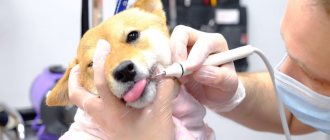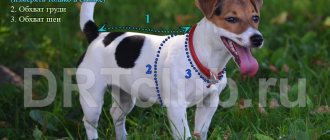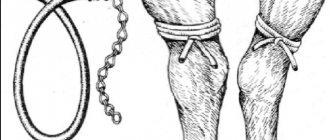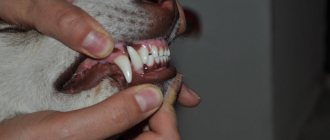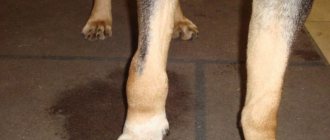Some owners have doubts and cannot say for sure whether flux occurs in dogs, or whether this disease is characteristic only of humans. The answer is simple - it happens. The main cause of oral diseases is insufficient hygiene. In the absence of competent care and the presence of other provoking factors, pets are no less vulnerable than their owners.
One of the possible complications of flux is meningitis, that is, inflammation of the meninges. For this reason, a sick animal must be examined at a veterinary clinic immediately after the first alarming symptoms appear.
What is periostitis, or gumboil in a dog?
The disease is an infectious inflammation of the periosteum - the tissue surrounding the jaw. Due to infection, serous exudate accumulates in the upper part of the diseased tooth, gradually transforming into pus. Over time, it penetrates the bone tissue and settles in the periosteum.
In addition to meningitis, the lack of timely treatment of the pathology is fraught with jaw deformation and tooth loss, the formation of phlegmon or abscess, as well as blood poisoning.
What to do if you find flux in your dog’s mouth: treatment methods
On October 20, 2021, the owner of an animal (dog, Chihuahua breed, age 10 years) came to the veterinary clinic “Svoy Doctor”, Kotelniki branch, with a complaint about a lump under the eye on the left side of the muzzle, on the upper jaw. Also, according to the owner, complaints about lethargy and loss of appetite and bad odor from the mouth
When examining the animal, the body temperature was 38.7. Visible mucous membranes are pale pink. During auscultation, wheezing and pathological noises are not auscultated. The animal's condition is satisfactory. When examining the site of compaction, there is an immature abscess of the soft tissues of the upper jaw.
When examining the oral cavity, there is abundant deposition of tartar on the teeth (molars) of the upper and lower jaws + severe trauma to the gums. Also, upon examination and an attempt to remove deposits on the teeth, it was found that the roots of two teeth were exposed, had practically no connection with the jaws and were very inflamed.
What is flux
Flux or periostitis is purulent inflammation of the periosteum. Typically, severe inflammation develops, in which the infection from the diseased tooth spreads to the surrounding tissue (periodontium) and jaw bone. It is characterized by severe pain, swelling of soft tissues, and the accumulation of large amounts of pus.
Typically, the dog will have asymmetrical swelling of the face or painful swelling at the site of the lesion.
In the absence of adequate treatment, the flux can develop into an abscess or diffuse phlegmon.
There are acute and chronic courses of the disease.
Causes:
- mouth infection;
- tooth inflammation;
- tooth injury;
- severe inflammation of the gums;
- inflammation of periodontal pockets;
- tartar.
It should be remembered that tartar, which so often forms in our pets, contributes to the enlargement of gum pockets (the space between the tooth and gum). It seems to move the gum away from the tooth.
This leads to chronic inflammation of the gums, and also creates favorable conditions for the development of infection.
Hair, pieces of food, and foreign objects (for example, chips from chewing sticks) get stuck in the resulting cavity, and subsequently a focus of inflammation is formed.
Signs: swelling of the muzzle, swelling of the cheeks; loss of appetite, refusal to eat; lethargy; fever during an acute process.
In agreement with the owner, a decision was made to remove (extract) two teeth (molars) under local anesthesia.
The manipulation was successful; the areas of suppuration and inflammation were treated with antiseptic solutions and anti-inflammatory drugs.
The owner was given further recommendations on oral care
A week later, the owner came back for a re-examination without any complaints, only a small wound remained at the site of inflammation.
You should be careful about the condition of your pet's oral cavity. If you experience bad breath, tartar, or discoloration of your teeth, it is best to undergo a preventive examination by a specialist.
Source:
Oral disease - gumboil
Dogs often develop oral diseases. In most cases, this occurs as a result of the fact that their owners do not properly monitor and care for the animal’s oral cavity. Basically, such cases end with dogs developing tartar, but an equally rare pathology is periostitis, or in other words, gumboil.
Flux in a pet is an inflammatory disease that starts from the gums and progresses to the periosteum. If the disease is advanced, jaw deformation is observed, teeth fall out, and sepsis may begin.
During this disease, the animal feels severe toothache. When the disease is even slightly advanced, even then the animal in most cases loses its teeth. The dog's muzzle may swell, or it may remain unchanged.
Types of disease
There are four types of gumboil in dogs:
- The first type is serous periostitis, the cause of which in most cases is mechanical trauma to the jaw. This type of disease is relatively easy. Swelling of the jaw and periosteum may be observed.
- The appearance of purulent formations on the jaw, in particular on the dog’s gums, indicates that the periostitis is acute and purulent. The animal loses its appetite, behaves quite restlessly, and is in poor general health.
- Diffuse is the most severe and dangerous form of this disease. It is impossible to see individual fluxes, since purulent inflammation spreads along the gums and periosteum. If the disease is not treated, it turns into sepsis. Therapeutic actions during this form are very complex.
- One of the rarest forms of this disease is chronic flux. It can develop in animals that have a weak immune system. And their immunity cannot withstand the ongoing processes in pathology.
If an inflammatory process of this type in a dog occurs on the lower part of the jaw, then it is not very dangerous. But when at the top, then it is necessary to show the pet to a specialized specialist at the veterinary emergency center. Because such a flux can turn into tissue phlegmon, and if the stage is very advanced, even into meningitis.
What reasons can trigger the appearance of periostitis in a dog?
The causes of periostitis in a dog may be the following:
- Dog oral infections;
- Inflammatory process of the tooth;
- Injury to the tooth;
- inflamed gums or periodontal pocket;
- The appearance of tartar.
Symptoms of the disease
- The animal loses its appetite, even if it eats only a little and at first glance you can understand that something is bothering it and causing inconvenience;
- The dog's restful sleep is disturbed, it whines and behaves restlessly;
- Teeth begin to loosen, this is the case if the disease is advanced;
- Blood can be found in a water vessel;
- An unpleasant odor emanates from the mouth, in which the “aroma” of pus is felt;
- There is swelling in the mouth;
- The animal regularly has a flow of saliva. Breeds such as the bulldog salivate quite profusely;
- The animal does not allow its head to be touched;
- It becomes noticeable that the pet eats only on one side;
- If the disease has spread to the upper jaw, it can also reach the nasal cavity. As a result, the animal regularly suffers from bleeding, which is not motivated by anything.
Types of pathology
Based on the nature and duration of the course, 4 types of pathology are distinguished. These include:
- Serous
. The mildest form that does not require long-term treatment. Occurs due to mechanical injuries (bruises in a fight or unsuccessful jumps).
- Purulent
. A severe form of the disease, observed at a later stage of development along with the appearance of purulent exudate.
- Diffuse
. The most dangerous form, developing against the background of advanced purulent inflammation. Over time, some of the pus enters the bloodstream, causing sepsis.
- Chronic
. It occurs less frequently than other forms and is characterized by a sluggish course and mild symptoms. It is observed in animals with weak immunity.
Before seeking help, try to analyze the possible causes of the inflammatory process. This information will help your veterinarian during diagnosis.
Flux in dogs: causes, symptoms and treatment methods
Oral diseases in dogs are not such a rare occurrence. They occur even more often than all other ailments. This situation is largely due to the owner’s oversight or improper behavior of the pet itself. Any owner of a four-legged animal should understand what periostitis is in an animal, what its symptoms and treatment methods are, as well as how to prevent the occurrence of an unpleasant disease.
Causes of tumor formation
The main reason for the appearance of gumboil in dogs is insufficient oral hygiene. Due to the lack of regular brushing of teeth, food particles accumulate and harden on the enamel. The resulting tartar expands the space between the gums and teeth. Pieces of food stuck in this gap rot and create pathogenic microflora that attract bacteria.
In addition to insufficient hyena, owners should pay attention to other provoking factors:
- complications of other oral pathologies (stomatitis, pulpitis, gingivitis);
- gum injuries from hard and sharp objects;
- hypothermia, colds and stress that weaken the immune system;
- lack of solid food in the diet, which prevents the natural removal of plaque from the enamel (abuse of soft canned food);
- secondary infection after removal of a diseased tooth;
- inflammation of the gum pocket - a favorite place for most harmful microorganisms.
As a result of a protracted inflammatory process, unilateral or bilateral swelling occurs on the animal’s face. The affected side increases in size, frightening the owners with its appearance.
Diagnosis and treatment
At the appointment, the veterinarian conducts a thorough examination of the oral cavity, assesses the damage, and records the stage of the disease process. To examine hidden damage, it is recommended to take an x-ray of the jaw. This procedure consists of an examination during anesthesia, the effect of which is designed strictly at the time of the operation, since if the dog is in severe pain, it will not allow itself to be examined. An X-ray of the oral cavity is taken with the dog's head in a specific position with its mouth completely open.
When the abscess has already fully formed, it needs to be opened, the resulting cavity should be washed with disinfectants, and if necessary, use a drainage system. Unfortunately, in 97% of situations, treating gumboil in a dog involves removing the damaged tooth. In cases where tartar has become a sign of the formation of complications, it is eliminated. Treatment at home involves washing the dental cavity with tinctures of chamomile, calendula, and oak peel. That is, herbs and substances that have a disinfecting effect. As a rule, if there is a risk of formation of jaw phlegmon, chemicals are introduced that can inhibit the growth and cause the death of bacteria.
So, this article describes what to do if your dog has gumboil. It is necessary to properly care for your pet's oral cavity. If there is a smell of rot from the mouth, tartar, or changes in the color of the teeth, you must consult a veterinarian and undergo an examination. It is also necessary to have your teeth cleaned to avoid significant problems in the future. Dogs of small and toy breeds that are predisposed to the rapid formation of tartar on their teeth should be seen by a doctor once every 6 months.
Symptoms at different stages of the disease
At the initial stage, behavioral changes appear. The pet often comes to the feeder, but due to pain, eats only on one side or spits out the food while chewing. A similar situation occurs with water, since the pain covers the entire jaw.
The serous form is accompanied by swelling of the jaw and swelling of the periosteum. At this stage, the pain is tolerable, so sleep disturbances and increased anxiety are not observed. Snoring may occur.
With the appearance of pus, sores appear on the gums. The entire oral cavity becomes very swollen and red. The cheek on the affected side swells. There is profuse salivation and increased body temperature.
When transitioning to the diffuse form, the animal constantly fiddles with its muzzle, whines and sleeps poorly. The mouth has an unpleasant rotten odor and often bleeds blood, which can be found in bowls of food and water. Teeth become loose and begin to fall out. When the infection enters the nasopharynx, the symptoms are complemented by nosebleeds.
What is periostitis
Periostitis is the development of inflammatory processes in the periosteum, which is the connective tissue covering the bones.
Importance for the body - participation in growth and provision of blood supply to a solid organ from the musculoskeletal system. Types of periostitis:
- aseptic type - without the entry of pathogenic microflora from the outside;
- septic type - with the participation of pathogenic microorganisms.
A likely complication when the pathological process is neglected is a disruption of blood flow in the periosteum, which leads to the development of tissue necrosis, that is, bone rotting. Other dangerous phenomena are malfunctions of the bone marrow, which weakens the immune system, and irreversible changes in the process of bone growth.
How is the treatment carried out?
The veterinarian decides what to do, taking into account the type of gumboil in the dog. Depending on the condition of the four-legged patient, the resulting inflammation is eliminated in 2 ways: conservative or surgical.
Antibiotic therapy
In most cases, a bacterial infection is to blame for the inflammatory process. To prevent its further development, broad-spectrum antibiotics are used (Amoxicillin, Tsiprovet, Ceftriaxone). Antibiotic therapy is prescribed at the initial stage of pathology or after surgery.
No less important is symptomatic therapy, including:
- painkillers that relieve pain;
- anti-inflammatory, stopping foci of inflammation;
- immunomodulators that stimulate the immune response.
If the abscess is fully formed, then taking medication alone will not be enough. In this case, the abscess is opened, washing and rinsing the resulting cavity with antiseptics.
Washing and rinsing
In addition to opening the abscess, it may be necessary to remove tartar. In both cases, mandatory sanitation of the oral cavity is carried out. For washing, use tinctures of oak bark, chamomile and calendula. These plants have a disinfecting effect and prevent the development of secondary infections.
Surgical intervention
A more radical solution to the problem is tooth extraction. The operation is performed in advanced forms of the disease using general anesthesia. The intervention is carried out in the clinic, and after it the patient is sent home for further treatment.
Is it possible to treat flux in dogs at home?
At the initial stage, excluding the absence of an abscess, the animal is given an anesthetic and anti-inflammatory. After this, the oral cavity is washed with a herbal decoction. To prepare it, you need to pour 1 liter of boiling water into 180 g of a dried mixture of St. John's wort, sage and oak bark. After 2 hours of infusion, the mixture is cooled, filtered and used to treat the affected area.
If periostitis occurs for the first time and there are no medications in the house to relieve inflammation and pain, be sure to consult a veterinarian. Selecting medications on your own is not safe.
Regardless of the condition, after all the manipulations have been carried out, the pet will have to be taken to the veterinary clinic. Full treatment at home can only be carried out after diagnosis, so limit your actions to first aid. Otherwise, you may not notice concomitant diseases and encounter new inflammation - in a more advanced form.
Flux treatment
After establishing the diagnosis, the veterinarian dentist, depending on the degree of the inflammatory process, prescribes appropriate treatment. There are 2 methods of treating pathology:
- conservative;
- operational.
The latter method is used in advanced forms of the disease. Basic manipulations:
- Application of anesthesia.
- An incision in the gum in the affected area of the diseased tooth.
- Puncture of bone tissue to allow pus to come out.
- Use of antiseptics.
- Installation of drainage. This is necessary for the remaining purulent formations to drain from the surgical site.
- Taking antibiotics to stop the inflammatory process.
- Removing drainage. After removing the rubber strip, bone tissue restoration begins. If the gums do not heal, the doctor puts stitches.
Extracted tooth
When the diseased tooth cannot be restored, it is removed. If the factor that provoked the development of gumboil was the formation of tartar, the oral cavity is sanitized and hard formations are removed. If there is a risk of phlegmon formation, the dog is prescribed drugs whose action leads to the death of pathogens.
In 97% of cases, when gumboil develops, the dog’s damaged tooth is removed.
With conservative therapy, anti-inflammatory drugs are prescribed
The conservative method consists of taking a course of medications that help reduce inflammation and suppress bacterial growth. For these purposes, the doctor prescribes the following medications:
- Anti-inflammatory. They fight infection and stop inflammation.
- Painkillers. Relieves pain.
- Immunomodulators. Improves the body's protective resources.
- Antihistamines . Prescribed in the presence of allergic reactions.
In addition to taking medications, the animal’s teeth are cleaned using ultrasound or chemicals.
Treatment at home
To help the pet cope with the disease, the owner should reduce its physical activity and refrain from training. It is necessary to provide the animal with a complete balanced diet, enriching the diet with mineral supplements, calcium-containing products and vitamins D and P.
In consultation with a doctor, the use of traditional medicine is allowed:
- Calamus root. Rubbing the affected area with calamus tincture with vodka is useful for stopping infectious processes.
- Propolis. Wound healing medicine. Melt a small amount of this product, mix with preheated vegetable oil and apply to the damaged area.
- Onion juice. Used as an antiseptic. Moisten the area around the diseased tooth with a swab.
- Cabbage leaf. Prevents pus formation. Apply the boiled leaf to the jaw for several minutes.
- Ice. Helps relieve swelling and relieve pain. Apply to the gum for a few seconds.
- Sage tea. Pour boiling water over 2 tbsp. herbs, leave for 2 hours and wipe the inflamed area.
- A decoction based on oak bark, chamomile and calendula. Take 1 tbsp. each ingredient, pour 1 liter of water and boil for 5 minutes in a water bath. After the liquid has infused, strain and rinse the mouth with it.
- Soda. Promotes the drainage of infection. Dissolve 1 tsp. substances in 1 glass of warm water and rinse the dog’s mouth. If purulent masses come out, alternate rinsing with soda with potassium permanganate or furatsilin.
The listed recipes are used several times a day until the pet is completely cured.
Sage infusion is a powerful anti-inflammatory agent
Animal care
During treatment, provide your four-legged pet with complete rest. Temporarily limit his activity by refusing training and participation in sports disciplines.
To avoid bone problems, review your current diet. Basic food products must contain sufficient amounts of phosphorus, calcium and vitamin D. If this is not possible, then the listed vitamins and minerals can be obtained from special complexes.
Until recovery, all food should be soft and warm. The absence of hard pieces and high temperatures will prevent injury to the already affected oral cavity.
Clean water and food bowls more thoroughly than before - using mild detergents and plenty of warm water. The animal's feeding area must be spotlessly clean so that there is no chance of secondary infection.
First necessary actions
Before starting therapy, it is necessary to have a good understanding of the cause of the disease. Treatment of flux in dogs at home begins with proper care of the animal, since appropriate care will contribute to a rapid recovery. The active movement of the dog should be limited.
Of course, this does not mean that the dog must be completely restricted from movement, but physical activity and training must be excluded. In addition, it is necessary to guarantee the pupil rational feeding in order to prevent the occurrence of additional complications with the bones. Therefore, add healthy vitamins and minerals (vitamins D, Ca, P) to your daily menu.
My dog has flux, what should I do? The first thing you need to do is immediately consult a doctor. The veterinarian will assess the severity and stage of the disease and, based on the findings, determine individual treatment.
Prevention measures
For the health of your four-legged friend, do not forget about preventive recommendations. Oral problems can be easily avoided by:
- Regular teeth cleaning
. Buy toothpaste with meat flavor to reduce mistrust of this unpleasant procedure. Ordinary gauze soaked in a soda solution is also suitable for cleaning.
- Proper combination of hard and soft foods
. Abuse of the first type is fraught with increased bleeding of the gums, and the second - the formation of tartar, loosening of the gums and subsequent tooth loss. Special chewing toys sold in pet stores are also suitable for cleaning plaque.
- Annual examinations at the veterinary clinic
. For dwarf breeds, the frequency of visits should be doubled, as they suffer more than others from dental diseases.
If tartar forms, contact your veterinarian immediately. Plaque can be eliminated using ultrasonic cleaning, preventing the development of complications.
Periostitis is a dangerous disease fraught with many complications. Despite this, it is quite easy to treat at the initial stage. To detect pathology, you need to carefully monitor your pet’s behavior, trying not to lose sight of even the most minor changes.
The article is for informational purposes only. Contact your veterinarian!
Do I need to see a veterinarian?
Dog breeders often wonder what to do if their dog has a large flux. In this case, you need to go to the veterinarian. Specialists should also be contacted in cases where treatment at home does not help or tooth extraction is required.
Only a veterinarian can correctly assess the dog’s condition. In addition, a full examination can be carried out at a veterinary hospital. Determining the severity of the disease usually requires x-rays and laboratory tests.
In advanced stages of the disease, surgery may be necessary. It’s good if it only involves opening the abscess. In some cases, the diseased tooth will have to be removed.
When the cause of periostitis is the formation of tartar, the clinic performs a procedure to remove it. This will need to be done to prevent the emergence of new lesions. If the cause of the gumboil lies in diseases of the gums, jaws or teeth, then the veterinarian will also prescribe the necessary treatment.



